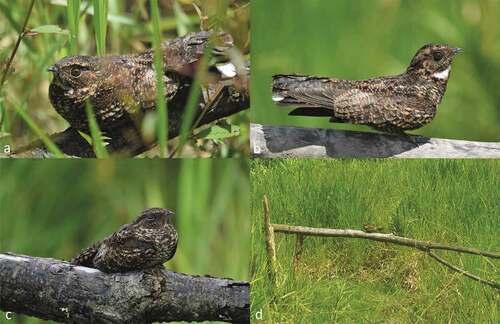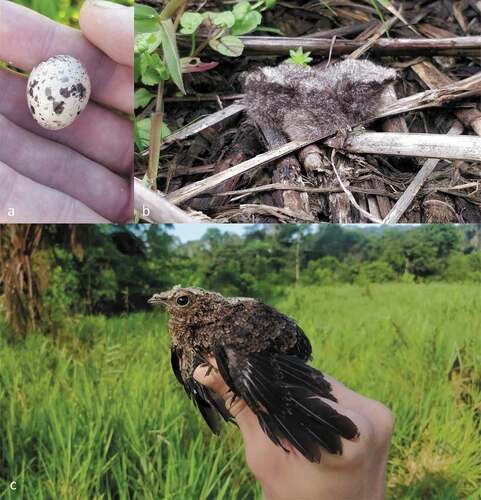We describe the first breeding record of a Blackish nightjar (Nyctipolus nigrescens) in a pasture habitat dominated by tropical grasses () located at the buffer zone of the Colonso-Chalupas Biological Reserve, in the Napo province in eastern Ecuador. The record was made during the wet season at the study area (March – June) and helps to fill a gap of observations on reproductive and breeding behaviour strategies of this species.
Figure 1. (a) Adult male roosting on a recently cut tree stem, (b) adult male showing head-bobbing behaviour in direct proximity of the nest, (c) adult female present on a tree stem near the nest site and (d) adult male in habitat

N. nigrescens are nocturnal insectivores that inhabit rocky outcrops, granite formations, sparsely vegetated open areas, trails and quiet roads and around rivers [Citation1–3]. This species is endemic to the neotropical region and its distribution ranges from Brazilian Amazonia to the southern Guianas and from south-eastern Colombia to eastern Ecuador and northern Bolivia in which it occurs from sea level to approximately 1200 m a.s.l. [Citation1–3]. In Ecuador, N. nigrescens occurs in non-inundated lowland forests above 300 m in elevation and in the eastern Andean foothills, being classified as “uncommon to rare” [Citation4,Citation5]. Since caprimulgids are mostly nocturnal and have cryptic behaviour, not a great deal of literature is available on their breeding strategies [Citation6]. Still, N. nigrescens is one of the best described Caprimulgidae regarding behaviour and breeding due to its large distribution range [Citation7]. So far, breeding records have been documented in Ecuador [Citation8,Citation9], Brazil [Citation10], Surinam [Citation11,Citation12], the Guianas [Citation13,Citation14] with also the documented double brood in French Guiana [Citation15] and aberrant coloured juveniles in Ecuador [Citation9].
Observations and discussion
The nest was found in an area of five hectares with patches of secondary non-inundated forests in a matrix of pastures consisting of tall tropical grasses and plantations, bordering the premontane forest of the Colonso-Chalupas Biological Reserve. The pasture was located at 640 m a.s.l. alongside a gravel road. Nest site (−77.8707°, −0.9444°) was situated about 30 meters away from the gravel road in a circular area with a diameter of 10 meters of trampled and withered grass. In the area, no rocky outcrops or granite formations were present.
All observations were made in April and May of 2019. The first observation was made on April 16th of an adult male that was flushed from the nest site location and landed on a stem of a tree that was recently cut down ()). After flushing, the bird landed about 30 meters away on another stem and showed its characteristic “head bobbing” ()). The second observation occurred on April 22nd. On that day, a pair was flushed from the same spot as mentioned before. The male directly flew out of sight over the nearby gravel road, while the female landed in the elevated stem, showed the “head bobbing” and made some calls of distress or distraction ()). On May 7th, the pair showed the same behaviour as was observed on April 22nd. An empty eggshell was found on May 8th in the same spot ()). On May 9th, the hatchling was found about four meters away from the location where the eggshell was found, sitting in the shadow of tall grasses ()). It was positioned on withered grass stems on blackened ground. During a visit on May 16th, both adults were observed and flushed from the nest site, but the juvenile could not be relocated. On May 28th, the juvenile was relocated and tried to hop towards dense cover of tropical grasses. By that time, it had grown to the adult size with half grown flight feathers but still with fuzzy body feathers ()). When revisiting the site on May 29th, the adult birds were relocated and flushed from the area. Forty-five days after first locating the breeding area, neither adults nor juveniles were observed
Figure 2. Blackish nightjar. (a) Empty eggshell found in the proximity of the nest site, (b) hatchling about 2 days old and (c) fledgling about 19 days old

The soil on which the eggshell was found was blackened and contrasted richly with the eggshell. This strategy is a so-called “adult adapted” nest site, where an incubating adult is nary detected since the soil and the adult have the same colour pattern [Citation10]. The nest site is aberrant as to what is previously described for this species since it is in the middle of a pasture of tall tropical grasses with little to no cover by shrubs or trees [Citation16]. Earlier observations noted that N. nigrescens occupy and reproduce in man-made habitats such as roadsides, gravel pits and laterite soils, but no mention of breeding in pastures has been made, although hunting and foraging in agricultural fields is a regular habit of this species [Citation17].
Most likely the pair was already breeding during the first observations. The total days from the first observation on April 16th up to the point the eggshell was found is 23 days. If the egg hatched several days before the eggshell was found or incubation started later than the adults were observed, the reported period would still be within the range of the incubation of 17–22 days [Citation13,Citation15]. When the hatchling was first observed it was about two days old based on photographs of juveniles [Citation9]. When returning after 19 days, the juvenile’s plumage was still not fully developed, suggesting a delayed plumage maturation, as N. nigrescens normally fledges after 17 days [Citation1]. Breeding from July to February has been recorded throughout its range [Citation13,Citation18], however breeding in Ecuador, including this record, seems to be concentrated from March to June [Citation8,Citation9]. Apart from the nest site location and the breeding period, our observations were in line with those reported in the literature. The nest consisted of one egg [Citation7] and this being one pair confirms the observations of solitary breeder characteristics [Citation18].
In Ecuador, breeding records are still restricted to the Andean foothills, and more observations are needed to better determine the breeding period and strategies of N. nigrescens within its distribution range, which includes lowland Amazonia, where no breeding observations have been made so far.
Disclosure statement
No potential conflict of interest was reported by the authors.
Correction Statement
This article has been republished with minor changes. These changes do not impact the academic content of the article.
References
- Cleere N, Nurney D. Nightjars – a guide to nightjars and related nightbirds. Cristopher Helm Publishers; 1998. London, UK.
- Cleere N. Nightjars. A guide to the nightjars, nighthawks, and their relatives. Yale University Press; 1998. New Haven, Connecticut, USA
- Holyoak DT, Woodcock M. Nightjars and their allies. Oxford University Press; 2001. Oxford, UK
- Freile J, Restall R. Birds of Ecuador. Helm Field Guides; 2018. Bloomsbury, London, UK
- Ridgely RS, Greenfield PJ. The birds of Ecuador. Helm Field Guides; 2001. Bloomsbury, London, UK
- Winkler DW, Billerman SM, Lovette IJ. Nightjars and allies (Caprimulgidae), version 1.0. In: Billerman SM, Keeney BK, Rodewald PG, et al., Editors. Birds of the world. Cornell Lab of Ornithology, Ithaca, NY, USA. 2020. https://doi.org/https://doi.org/10.2173/bow.caprim2.01
- Bemis K. Blackish Nightjar (Nyctipolus nigrescens), version 1.0. In: Schulenberg TS, Editor. Birds of the world. Ithaca, NY, USA: Cornell Lab of Ornithology; 2020.
- Greeney H, Gelis R. Breeding records from the north-east Andean foothills of Ecuador. Bull Br Ornithol Club. 2007;127:236–241.
- Solano-Ugalde A, Vits C, Ingels J. Notes on the breeding of the Blackish Nightjar (Caprimulgus nigrescens) in south-eastern Ecuador, including the first record of aberrantly coloured juveniles NOTAS. Boletín SAO. 2012;21:50–57.
- Roth P. Breeding biology of the Blackish Nightjar, Caprimulgus nigrescens, in Western Brazil. Le Gerfaut. 1985;75:253–264.
- Ingels J. Notes on some surinam birds. Bull Br Ornithol Club. 1981;101:367.
- Ingels J, Ribot J-H, de Jong BHJ. Vulnerability of eggs and young of the Blackish Nightjar (Caprimulgus nigrescens) in Suriname. the Auk. 1984;101:388–391.
- Cleere N, Ingels J. Notes on the breeding biology of the Blackish Nightjar Caprimulgus nigrescens in French Guiana. Alauda. 2002;70:253–259.
- Beebe W. Tropical wild life in British Guiana. New York city: The New York Zoological Society; 1917. p. 218–221.
- Ingels J, Costa TVV, Brammer FP, et al. Clutch size of Blackish Nightjar Nyctipolus nigrescens. Bull Br Ornithol Club. 2017;137: 135–141.
- Ingels J. A review of the neotropical nightjar species group Caprimulgus maculosus, C. nigrescens and C. whitelyi. Bull Br Ornithol Club. 2001;121:110–116.
- Ingels J, Oniki Y, Willis EO. Opportunistic adaptations to man-induced habitat changes by some South American caprimulgidae. Rev Bras Biol. 1999;59: 563–566.
- Jackson HD, Ingels J. Comparison of the two Rupicolous nightjars: the Afrotropical Freckled Nightjar Caprimulgus tristigma and the neotropical Blackish Nightjar C. nigrescens. Ostrich. 2010;81:145–148.
